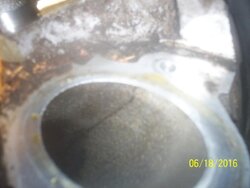what to time?
The camshaft timing procedure in the shop manual times both camshafts: first the right and second the left. Compressed valve springs put pressure on the cam lobes causing the camshaft to rotate relative to the crankshaft when not held in place.
The keyed crankshaft sprocket drives the jackshaft front sprocket via the primary chain. Only the friction between the jackshaft front hub,
the jackshaft to left camshaft chain sprocket,
and the jackshaft primary chain sprocket caused by the sprocket retaining bolt keep everything in place.
If the jackshaft front sprocket retaining bolt is loosened then both camshafts must be timed.
If
only the left camshaft sprocket retaining bolt is loosened then only the left camshaft must be timed.
If
only the jackshaft rear sprocket retaining bolt and/or the right camshaft sprocket retaining bolt are loosened then only the right camshaft must be timed.
However, since the crankshaft rotates two revolutions for each camshaft revolution it is possible to have one camshaft timed 180 degrees off relative to the other when piston one is at TDC. You must verify that piston 1 is at TDC on the compression stroke as indicated by the offset slots in both camshafts when timing either camshaft.
Note: It is not necessary to remove the front cover when timing the camshafts. The camshafts can be timed by loosening and tightening the camshaft sprocket retaining bolts.












